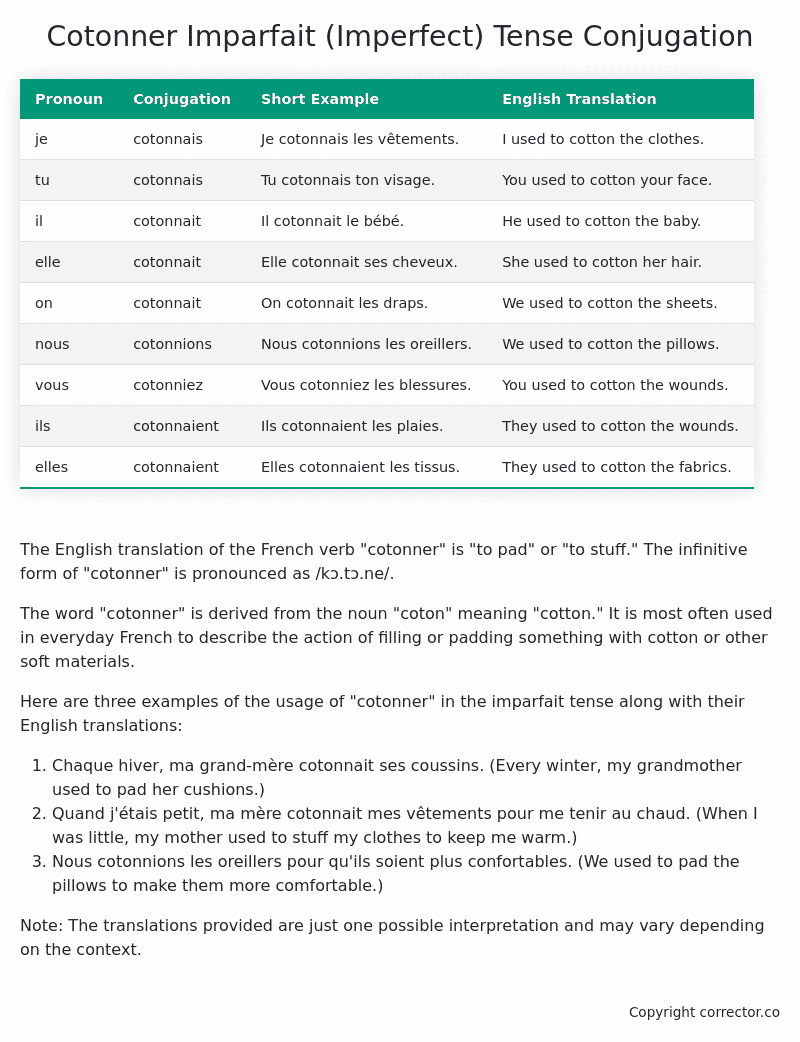Imparfait (Imperfect) Tense Conjugation of the French Verb cotonner
Introduction to the verb cotonner
The English translation of the French verb “cotonner” is “to pad” or “to stuff.” The infinitive form of “cotonner” is pronounced as /kɔ.tɔ.ne/.
The word “cotonner” is derived from the noun “coton” meaning “cotton.” It is most often used in everyday French to describe the action of filling or padding something with cotton or other soft materials.
Here are three examples of the usage of “cotonner” in the imparfait tense along with their English translations:
- Chaque hiver, ma grand-mère cotonnait ses coussins. (Every winter, my grandmother used to pad her cushions.)
- Quand j’étais petit, ma mère cotonnait mes vêtements pour me tenir au chaud. (When I was little, my mother used to stuff my clothes to keep me warm.)
- Nous cotonnions les oreillers pour qu’ils soient plus confortables. (We used to pad the pillows to make them more comfortable.)
Note: The translations provided are just one possible interpretation and may vary depending on the context.
Table of the Imparfait (Imperfect) Tense Conjugation of cotonner
| Pronoun | Conjugation | Short Example | English Translation |
|---|---|---|---|
| je | cotonnais | Je cotonnais les vêtements. | I used to cotton the clothes. |
| tu | cotonnais | Tu cotonnais ton visage. | You used to cotton your face. |
| il | cotonnait | Il cotonnait le bébé. | He used to cotton the baby. |
| elle | cotonnait | Elle cotonnait ses cheveux. | She used to cotton her hair. |
| on | cotonnait | On cotonnait les draps. | We used to cotton the sheets. |
| nous | cotonnions | Nous cotonnions les oreillers. | We used to cotton the pillows. |
| vous | cotonniez | Vous cotonniez les blessures. | You used to cotton the wounds. |
| ils | cotonnaient | Ils cotonnaient les plaies. | They used to cotton the wounds. |
| elles | cotonnaient | Elles cotonnaient les tissus. | They used to cotton the fabrics. |
Other Conjugations for Cotonner.
Le Present (Present Tense) Conjugation of the French Verb cotonner
Imparfait (Imperfect) Tense Conjugation of the French Verb cotonner (You’re reading it right now!)
Passé Simple (Simple Past) Tense Conjugation of the French Verb cotonner
Passé Composé (Present Perfect) Tense Conjugation of the French Verb cotonner
Futur Simple (Simple Future) Tense Conjugation of the French Verb cotonner
Futur Proche (Near Future) Tense Conjugation of the French Verb cotonner
Plus-que-parfait (Pluperfect) Tense Conjugation of the French Verb cotonner
Passé Antérieur (Past Anterior) Tense Conjugation of the French Verb cotonner
Futur Antérieur (Future Anterior) Tense Conjugation of the French Verb cotonner
Subjonctif Présent (Subjunctive Present) Tense Conjugation of the French Verb cotonner
Subjonctif Passé (Subjunctive Past) Tense Conjugation of the French Verb cotonner
Subjonctif Imparfait (Subjunctive Imperfect) Tense Conjugation of the French Verb cotonner
Subjonctif Plus-que-parfait (Subjunctive Pluperfect) Tense Conjugation of the French Verb cotonner
Conditionnel Présent (Conditional Present) Tense Conjugation of the French Verb cotonner
Conditionnel Passé (Conditional Past) Tense Conjugation of the French Verb cotonner
Conditionnel Passé II (Conditional Past II) Tense Conjugation of the French Verb cotonner
L’impératif Présent (Imperative Present) Tense Conjugation of the French Verb cotonner
L’impératif Passé (Imperative Past) Tense Conjugation of the French Verb cotonner
L’infinitif Présent (Infinitive Present) Tense Conjugation of the French Verb cotonner
L’infinitif Passé (Infinitive Past) Tense Conjugation of the French Verb cotonner
Le Participe Présent (Present Participle) Tense Conjugation of the French Verb cotonner
Le Participe Passé (Past Participle) Tense Conjugation of the French Verb cotonner
Struggling with French verbs or the language in general? Why not use our free French Grammar Checker – no registration required!
Get a FREE Download Study Sheet of this Conjugation 🔥
Simply right click the image below, click “save image” and get your free reference for the cotonner imparfait tense conjugation!

Cotonner – About the French Imparfait Tense
NOTE: To take a deep dive into all the French tenses then see our article on Mastering French Tense Conjugation.
Formation of the Imparfait Tense
For regular -er verbs:
For regular -ir verbs
For regular -re verbs
Common Everyday Usage Patterns
Description of Past Habits
Background Information
Mental and Emotional States
It’s employed to express emotions, thoughts, or physical sensations in the past. For example: “J’étais content quand il est arrivé.” (I was happy when he arrived.)
Ongoing Actions
Points to Note About the Imparfait Tense
Passé Composé vs. Imparfait
Conditional
Si Clauses
Narration
I hope you enjoyed this article on the verb cotonner. Still in a learning mood? Check out another TOTALLY random French verb imparfait conjugation!


